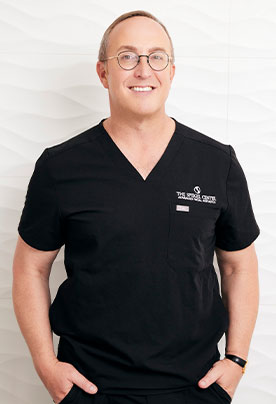
If you wake up with a tension headache after a night of clenching your teeth, you’re not alone. Bruxism is a common condition characterized by teeth clenching and grinding affecting millions of people nationwide for which your dentist will likely prescribe a device called a nightguard to protect the enamel of your teeth. However, a nightguard does not change a bad habit and in most cases does not relieve the tension. This habitual behavior of grinding and clenching can lead to a range of unpleasant symptoms, including jaw pain, headaches, and worn-down teeth. While there are various treatments available to manage bruxism, one innovative approach that is relatively simple has gained popularity in recent years: Masseter Botox injections. Newer formulations of the Botox® brand name are Dysport®, Xeomin®, Jeuveau® and Daxxify®.
For a while now we’ve known that botulinum products like Botox®, Dysport®, Xeomin®, Jeuveau® and Daxxify® work to alleviate bruxism (clenching) symptoms when injected into the masseter muscle. These neurotoxins are derived from the bacterium Clostridium botulinum, commonly associated with cosmetic procedures such as treating angry 11 wrinkles between the eyebrows, forehead lines, and crow’s feet. However, in the context of bruxism, botulinum is injected into the masseter muscle, which is one of 5 muscles of mastication, and the biggest muscle that’s responsible for jaw clenching. Hence, the term Masseter Botox. By temporarily relaxing the masseter muscle, the botulinum reduces the frequency and intensity of teeth grinding and clenching. This, in turn, provides relief from associated symptoms such as jaw pain, headaches, and teeth wear. The effects of botulinum typically last for several months, making it a convenient and relatively long-lasting solution for individuals struggling with bruxism.
One of the primary benefits of using botulinum for bruxism is its minimally invasive nature. Unlike more traditional treatments, such as mouthguards or oral appliances, Botox injections do not require significant lifestyle changes or cumbersome devices. This makes it an attractive option for individuals who prefer a more discreet and easy approach to manage their condition. Furthermore, Botox has been shown to be highly effective in reducing bruxism symptoms, with some studies suggesting a success rate of up to 90%. This is particularly significant, given that bruxism can have a profound impact on quality of life, affecting not only oral health but also overall well-being.
While Botox®, Dysport®, Xeomin®, Jeuveau® and Dassxify® offer numerous advantages, these treatments are not without their limitations. One potential drawback is the temporary nature of the treatment, which requires periodic repeated injections to maintain its effectiveness. Additionally, Botox may not be suitable for everyone. As with any medical procedure, there is also a risk of side effects, such as facial asymmetry or an uneven smile, although these are uncommon and generally mild and temporary. Furthermore, the cost of these injections may be a barrier for some individuals, as it is not usually covered by insurance providers.
In conclusion, botulinum has emerged as a promising treatment option for individuals struggling with bruxism and teeth clenching. By temporarily relaxing the masseter muscle, Botox can provide significant relief from symptoms such as jaw pain, headaches, and teeth wear. As research continues to uncover the full potential of botulinum in alleviating bruxism symptoms, it is likely that this innovative treatment will become an increasingly popular choice for individuals seeking relief from the debilitating effects of teeth clenching and grinding.
As for tension headaches, injections to the masseter and adjacent muscles, such as the trapezius, and those same muscles that cause wrinkles in the forehead and eyes can help tremendously. But that's a topic for another blog. Please let us know if you found this information helpful by sending us a comment, and share other topics you'd like to hear about.







